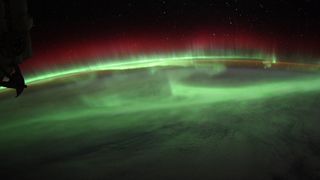Astronaut spots bright aurora storm from the International Space Station (photos)
The "spectacular" show came after a big outburst from our sun.

A solar storm sparked a shimmering aurora visible in space.
NASA astronaut Bob Hines caught the aurora on camera from the International Space Station on Wednesday (Aug. 17) following a moderate solar outburst.
"Absolutely SPECTACULAR aurora today!!!," the NASA astronaut tweeted, along with several pictures of the sun-generated storm that hit the atmosphere of Earth. "Thankful for the recent solar activity resulting in these wonderful sights."
The northern lights were generated after the sun hurled enough charged particles towards our planet to produce a moderate or G2-class storm, according to SpaceWeather.com.
Related: Hyperactive sunspot just hurled a huge X-class solar flare into space

NASA astronaut Bob Hines captured a spectacular set of auroras from the International Space Station on Aug. 17, 2022.

Hines captured the footage from about 250 miles (400 km) above the Earth.

The auroras were generated from a solar storm that hurled charged particles towards our planet.

As the charged particles hit magnetic lines of Earth, the electrical activity "excited" atmospheric gases and created the beautiful show.
The northern lights or aurora borealis occur when the sun sends a swarm of charged particles towards our planet, called a coronal mass ejection. Since the particles have electrical charge, Earth's magnetic field attracts them.
The bits of the sun flow along the magnetic lines near our planet's poles and generate a glow as atmospheric molecules are "excited" by the electrical activity. (Other planets and moons have auroras as well, through various mechanisms.)
Get the Space.com Newsletter
Breaking space news, the latest updates on rocket launches, skywatching events and more!

In most cases, the solar storms we experience on Earth are harmless, but on occasion strong bursts of space weather can also create infrastructure problems as power lines, satellites or other machinery shorts out.
Hines, his roommates on the space station and other folks in space also need to be mindful of radiation associated with space weather and cosmic rays, which are generated from deep space. But medical doctors keep an eye on astronaut health before, during and after space missions.
European Space Agency astronaut Samantha Cristoforetti also saw auroras earlier this week.
In those bright nights around the full Moon you can see features on the planet surface even at night. From the Cupola the view is “upside down” - flying above clouds feels like looking up at the sky from Earth. Cloud gazing and stargazing at the same time! https://t.co/NyB2TQ7oIu pic.twitter.com/i7eXdO4RtEAugust 16, 2022
If you captured a stunning photo of the northern lights let us know! You can send in images and comments to Space.com by emailing spacephotos@space.com. Be sure to let us know your name, where you were observing from and what it was like to see the auroras.
Follow Elizabeth Howell on Twitter @howellspace. Follow us on Twitter @Spacedotcom or on Facebook.
Join our Space Forums to keep talking space on the latest missions, night sky and more! And if you have a news tip, correction or comment, let us know at: community@space.com.

Elizabeth Howell (she/her), Ph.D., is a staff writer in the spaceflight channel since 2022 covering diversity, education and gaming as well. She was contributing writer for Space.com for 10 years before joining full-time. Elizabeth's reporting includes multiple exclusives with the White House and Office of the Vice-President of the United States, an exclusive conversation with aspiring space tourist (and NSYNC bassist) Lance Bass, speaking several times with the International Space Station, witnessing five human spaceflight launches on two continents, flying parabolic, working inside a spacesuit, and participating in a simulated Mars mission. Her latest book, "Why Am I Taller?", is co-written with astronaut Dave Williams. Elizabeth holds a Ph.D. and M.Sc. in Space Studies from the University of North Dakota, a Bachelor of Journalism from Canada's Carleton University and a Bachelor of History from Canada's Athabasca University. Elizabeth is also a post-secondary instructor in communications and science at several institutions since 2015; her experience includes developing and teaching an astronomy course at Canada's Algonquin College (with Indigenous content as well) to more than 1,000 students since 2020. Elizabeth first got interested in space after watching the movie Apollo 13 in 1996, and still wants to be an astronaut someday. Mastodon: https://qoto.org/@howellspace
Most Popular


